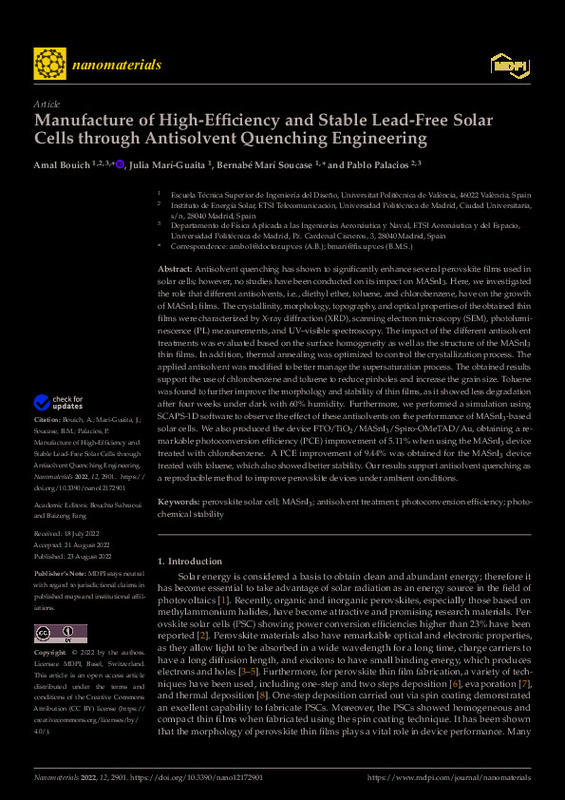JavaScript is disabled for your browser. Some features of this site may not work without it.
Buscar en RiuNet
Listar
Mi cuenta
Estadísticas
Ayuda RiuNet
Admin. UPV
Manufacture of High-Efficiency and Stable Lead-Free Solar Cells through Antisolvent Quenching Engineering
Mostrar el registro sencillo del ítem
Ficheros en el ítem
| dc.contributor.author | Bouich, Amal
|
es_ES |
| dc.contributor.author | Marí-Guaita, Julia
|
es_ES |
| dc.contributor.author | Marí, B.
|
es_ES |
| dc.contributor.author | Palacios, Pablo
|
es_ES |
| dc.date.accessioned | 2023-06-20T18:01:51Z | |
| dc.date.available | 2023-06-20T18:01:51Z | |
| dc.date.issued | 2022-09 | es_ES |
| dc.identifier.uri | http://hdl.handle.net/10251/194432 | |
| dc.description.abstract | [EN] Antisolvent quenching has shown to significantly enhance several perovskite films used in solar cells; however, no studies have been conducted on its impact on MASnI(3). Here, we investigated the role that different antisolvents, i.e., diethyl ether, toluene, and chlorobenzene, have on the growth of MASnI(3) films. The crystallinity, morphology, topography, and optical properties of the obtained thin films were characterized by X-ray diffraction (XRD), scanning electron microscopy (SEM), photoluminescence (PL) measurements, and UV-visible spectroscopy. The impact of the different antisolvent treatments was evaluated based on the surface homogeneity as well as the structure of the MASnI(3) thin films. In addition, thermal annealing was optimized to control the crystallization process. The applied antisolvent was modified to better manage the supersaturation process. The obtained results support the use of chlorobenzene and toluene to reduce pinholes and increase the grain size. Toluene was found to further improve the morphology and stability of thin films, as it showed less degradation after four weeks under dark with 60% humidity. Furthermore, we performed a simulation using SCAPS-1D software to observe the effect of these antisolvents on the performance of MASnI(3)-based solar cells. We also produced the device FTO/TiO2/MASnI(3)/Spiro-OMeTAD/Au, obtaining a remarkable photoconversion efficiency (PCE) improvement of 5.11% when using the MASnI(3) device treated with chlorobenzene. A PCE improvement of 9.44% was obtained for the MASnI(3) device treated with toluene, which also showed better stability. Our results support antisolvent quenching as a reproducible method to improve perovskite devices under ambient conditions. | es_ES |
| dc.description.sponsorship | The author Amal Bouich postdoctoral researcher acknowledges Margarita Salas Fellowship (MCIN/AEI/10.13039/501100011033) for funding support. This work was supported by EU under Project PID2019-107137RB-C21 and by ERDF under the funding "A way of making Europe". This work was supported by the Ministerio de Ciencia e Innvacion through the project BESTMAT (PID2019107137RB-C21) and (PID2019-107137RB-C22). | es_ES |
| dc.language | Inglés | es_ES |
| dc.publisher | MDPI AG | es_ES |
| dc.relation.ispartof | Nanomaterials | es_ES |
| dc.rights | Reconocimiento (by) | es_ES |
| dc.subject | Perovskite solar cell | es_ES |
| dc.subject | MASnI3 | es_ES |
| dc.subject | Antisolvent treatment | es_ES |
| dc.subject | Photoconversion efficiency | es_ES |
| dc.subject | Photochemical stability | es_ES |
| dc.subject.classification | FISICA APLICADA | es_ES |
| dc.title | Manufacture of High-Efficiency and Stable Lead-Free Solar Cells through Antisolvent Quenching Engineering | es_ES |
| dc.type | Artículo | es_ES |
| dc.identifier.doi | 10.3390/nano12172901 | es_ES |
| dc.relation.projectID | info:eu-repo/grantAgreement/AEI/Plan Estatal de Investigación Científica y Técnica y de Innovación 2017-2020/PID2019-107137RB-C21/ES/MEJORANDO LA PRODUCCION DE ENERGIA SOLAR CON PEROVSKITAS INORGANICAS.SINTESIS/ | es_ES |
| dc.relation.projectID | info:eu-repo/grantAgreement/GVA AGRICULTURA//AGPIDI%2F2022%2F46%2F009//IMPRESION DE CELULAS SOLARES DE PEROVSKITAS PARA GENERACION DE ENERGIA VERDE/ | es_ES |
| dc.relation.projectID | info:eu-repo/grantAgreement/AEI/Plan Estatal de Investigación Científica y Técnica y de Innovación 2017-2020/PID2019-107137RB-C22/ES/MEJORANDO LA PRODUCCION DE ENERGIA SOLAR CON MATERIALES SEMICONDUCTORES BASADOS EN PEROVSKITAS INORGANICAS-CALCULOS CUANTICOS/ | es_ES |
| dc.relation.projectID | info:eu-repo/grantAgreement/UNIVERSIDAD POLITECNICA DE VALENCIA//MS%2F27//AYUDA MARGARITA SALAS DE BOUICH, AMAL/ | es_ES |
| dc.rights.accessRights | Abierto | es_ES |
| dc.contributor.affiliation | Universitat Politècnica de València. Escuela Técnica Superior de Ingeniería del Diseño - Escola Tècnica Superior d'Enginyeria del Disseny | es_ES |
| dc.description.bibliographicCitation | Bouich, A.; Marí-Guaita, J.; Marí, B.; Palacios, P. (2022). Manufacture of High-Efficiency and Stable Lead-Free Solar Cells through Antisolvent Quenching Engineering. Nanomaterials. 12(17):1-14. https://doi.org/10.3390/nano12172901 | es_ES |
| dc.description.accrualMethod | S | es_ES |
| dc.relation.publisherversion | https://doi.org/10.3390/nano12172901 | es_ES |
| dc.description.upvformatpinicio | 1 | es_ES |
| dc.description.upvformatpfin | 14 | es_ES |
| dc.type.version | info:eu-repo/semantics/publishedVersion | es_ES |
| dc.description.volume | 12 | es_ES |
| dc.description.issue | 17 | es_ES |
| dc.identifier.eissn | 2079-4991 | es_ES |
| dc.identifier.pmid | 36079939 | es_ES |
| dc.identifier.pmcid | PMC9457650 | es_ES |
| dc.relation.pasarela | S\471597 | es_ES |
| dc.contributor.funder | GENERALITAT VALENCIANA | es_ES |
| dc.contributor.funder | AGENCIA ESTATAL DE INVESTIGACION | es_ES |
| dc.contributor.funder | Agencia Estatal de Investigación | es_ES |
| dc.contributor.funder | European Regional Development Fund | es_ES |
| dc.contributor.funder | UNIVERSIDAD POLITECNICA DE VALENCIA | es_ES |








